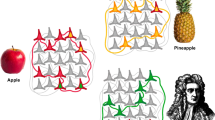Abstract
In a technical report submitted in 1948, Alan Turing presented a far-sighted survey of the prospect of constructing machines capable of intelligent behaviour. This report was all the more remarkable for having been written at a time when the first programmable digital computers were just beginning to be built, leaving Turing with only paper and pencil with which to explore his modern computational ideas. Turing may have been the first to suggest using randomly connected networks of neuron-like nodes to perform computation, and proposed the construction of large, brain-like networks of such neurons capable of being trained as one would teach a child. Some modern work has been performed on Turing’s neural networks, but all of it involves the invention of new structures outside the scope of Turing’s original specifications in order to solve a technical error on Turing’s part. I propose an alternative solution to Turing’s technical error, one which does not require the invention of new structures, and outline an approach which may allow the better exploration of the particular properties of Turing’s networks in their own right. I also give examples of ways in which to avoid viewing Turing’s early and strikingly original work through the lens of the conventions of modern neural network theory. Using a “genetical” search to configure such networks, as Turing suggested, is likely to yield non-intuitive or algorithmically opaque results, but this is likely to be a property of brain-like networks themselves, and a sign we are approaching Turing’s initial goal.







Similar content being viewed by others
References
Hodges A (1992) Alan Turing—the enigma. Vintage, London
Ball P (1999) The self-made tapestry—pattern formation in nature. Oxford University Press, New York
Turing AM (1948) Intelligent machinery. National Physical Laboratory Report. Subsequently published. In: Meltzer B, Michie D (eds) (1969) Machine intelligence, vol 5, Edinburgh University Press, Edinburgh, pp 3–23
Ince DC (ed) (1992) Collected works of A. M. Turing—mechanical intelligence. North Holland, Amsterdam
Mitchell M (1997) An introduction to genetic algorithms. MIT Press, Cambridge, Massachusetts
Webster C (2001) Copeland and Proudfoot miss the mark. http://compucology.net/criticism. Accessed 11 June 2011
Copeland BJ, Proudfoot D (1996) On Alan Turing’s anticipation of connectionism. Synthese 108:361–377
Teuscher C (2002) Turing’s connectionism—an investigation of neural network architectures. Springer, London
Copeland BJ, Proudfoot D (1999) Alan Turing’s forgotten ideas in computer science. Sci Am 280:76–81
Webster CS (2005) Alan Turing—life and legacy of a great thinker. Prometheus 23:352–356
Teuscher C (2004) Turing’s connectionism. In: Teuscher C (ed) Alan Turing—life and legacy of a great thinker. Springer, Berlin, pp 499–529
Kauffman SA (1993) The origins of order—self-organisation and selection in evolution. Oxford University Press, New York
Webster C (2002) The WB-type network, unstable states and evolution. http://compucology.net/wbtype. Accessed 11 June 2011
Dwyer C, Lebeck AR, Sorin DJ (2005) Self-assembled architectures and the temporal aspects of computing. Computer 38:56–64
Moravec H (1990) Mind children - the future of robot and human intelligence. Harvard University Press, Cambridge, Massachusetts
Jones EG, Mendell LM (1999) Assessing the decade of the brain. Science 284:739
Mitchell M (2009) Complexity—a guided tour. Oxford University Press, New York
Cui M, Copsey L, Green AA, Bangham JA, Coen E (2010) Quantitative control of organ shape by combinatorial gene activity. PLoS Biol 8:e1000538
Freeman WJ, Kozma R, Werbos PJ (2001) Biocomplexity—adaptive behavior in complex stocastic dynamical systems. Biosystems 59:109–123
Watts DJ, Strogatz SH (1998) Collective dynamics of “small-world” networks. Nature 393:440–442
Collins JJ, Chow CC (1998) It’s a small world. Nature 393:409–410
Bearman PS, Moody J, Stovel K (2004) Chains of affection—the structure of adolescent romantic and sexual networks. Am J Sociol 110:44–91
Hansen TF (2003) Is modularity necessary for evolvability? Remarks on the relationship between pleiotropy and evolvability. Biosystems 69:83–94
Vaadia E, Haalman I, Abeles M et al (1995) Dynamics of neuronal interactions in monkey cortex in relation to behavioural events. Nature 373:515–518
The NIH Human Connectome Project (2010) The NIH Human Connectome Project. http://www.humanconnectome.org/consortia/. Accessed 11 June 2011
London M, Hausser M (2005) Dendritic computation. Annu Rev Neurosci 28:503–532
Cuntz H, Forstner F, Borst A, Hausser M (2010) One rule to grow them all—a general theory of neuronal branching and its practical application. PLoS Comput Biol 6:e1000877
Garcia-Cairasco N (2009) Learning about brain physiology and complexity from the study of the epilepsies. Braz J Med Biol Res 42:76–86
Webster CS (2006) Resistance is futile—the future and post-humanity. Prometheus 24:341–348
Kelly K (1995) Out of control—the new biology of machines. Fourth Estate, London
de Garis H, Korkin M (2002) The CAM-brain machine (CBM)—an FPGA-based hardware tool that evolves a 1000 neuron-net circuit module in seconds and updates a 75 million neuron artificial brain for real-time robot control. Neurocomputing 42:35–68
Ehrlich PR (1988) The machinery of nature. Simon and Schuster, London
Zimmer C (2001) Parasite rex—inside the bizarre world of nature’s most dangerous creatures. Free Press, New York
Pfeifer R, Lungarella M, Iida F (2007) Self-organization, embodiment and biologically inspired robotics. Science 318:1088–1093
Webster CS (2008) Implementing safety in medicine—the problem, the pitfalls and a successful safety initiative in anaesthesia. VDM Verlag, Saarbrucken, Germany
Sipper M (2002) Machine nature—the coming age of bio-inspired computing. McGraw-Hill, New York
Webster C, Fleming W (2000) Evolved Turing neural networks. http://compucology.net/evolved. Accessed 11 June 2011
Agnati LF, Guidolin D, Carone C et al (2007) Understanding neuronal molecular networks builds on neuronal cellular network architecture. Brain Res Rev 58:379–399
Agnati LF, Guidolin D, Fuxe K (2007) The brain as a system of nested but partially overlapping networks—heuristic relevance of the model for brain physiology and pathology. J Neural Transm 114:3–19
Webster CS (2007) The personalisation of computing—from behemoth to desktop. Prometheus 25:187–193
Acknowledgments
Thank you to Andrew Hodges for discussion around this topic over many years and to William Fleming for work in generating Fig. 7.
Author information
Authors and Affiliations
Corresponding author
Rights and permissions
About this article
Cite this article
Webster, C.S. Alan Turing’s unorganized machines and artificial neural networks: his remarkable early work and future possibilities. Evol. Intel. 5, 35–43 (2012). https://doi.org/10.1007/s12065-011-0060-5
Received:
Revised:
Accepted:
Published:
Issue Date:
DOI: https://doi.org/10.1007/s12065-011-0060-5




